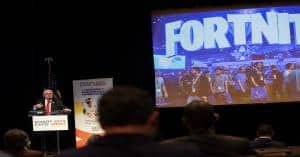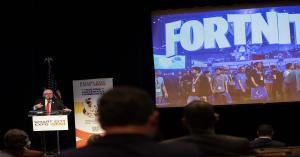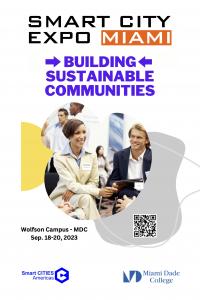Keynote by Paul Doherty - Photo Tere Garcia Day two of Smart City Expo Miami - Building Sustainable Communities proved to be another success bringin
Day two of Smart City Expo Miami – Building Sustainable Communities proved to be another success bringing together speakers from across the country – and world.
MIAMI, FLORIDA, UNITED STATES OF AMERICA, September 29, 2023 /EINPresswire.com/ — Day two of Smart City Expo Miami – Building Sustainable Communities, produced by Smart Cities Americas, proved to be another success as speakers from across the country – and world – came together to discuss the importance of making our cities more resilient in the face of climate change, and the need for people-friendly urban environments.
In a time marked by unprecedented urbanization, the escalating impacts of climate change and mental and physical health crises, cities around the world must invest in resilient and citizen-friendly infrastructure. SCEM23 day two’s impressive group of speakers all gave unique presentations, however, they all greatly emphasized the need to foster healthier urban environments and mitigate damage from the effects of climate change. Furthermore, they all agree that no single industry can tackle these challenges alone. Collaboration and interconnectedness between businesses, governments, universities, and citizens are essential to figuring out innovative solutions and making smarter cities.
Smart cities are people-centric
Keynote speaker Paul Doherty, President and CEO of the Digit Group, discussed his collaborations with Saudi Arabia in conceptualizing and reimagining sustainable urban environments, which they have done by using AI models. Through this work, they have planned for Abu Dhabi’s first net-zero building which will use waterfalls to generate hydropower.
In his presentation, Andy Boenau provided some sobering statistics on the state of mental and physical health across the country and pointed out that we are at a crisis point. Boenau attributed this to damaging infrastructure – meaning, infrastructure that does not center the needs of citizens.
“Infrastructure can heal. Infrastructure can liberate.” Andy Boenau
Kurt Kaminer and Hank Resnik also emphasized the need to improve our urban infrastructures, specifically for the benefit of kids.
Elisa Silva similarly discussed the issue of spatial inequality and the need for settlement integration and strengthening rural landscapes. So, how can we face this growing infrastructure issue and spatial inequality? Innovation appears to be among the most necessary tools.
David Graham, CIO of Carlsbad, CA, shared his vision of a people-centric community, one that he is implementing in his own city. Graham stressed the role of innovation in connecting communities, and how, in turn, connected communities are able to be more innovative.
How do we foster a more engaged, connected, and innovative community? According to Graham, the citizens of Carlsbad wanted to pursue a community-wide digital transformation. This would build a capacity for data-driven decision-making, foster a vibrant civic engagement culture, enhance accessibility and transparency, and promote safety and sustainability through connectivity. These five elements create a basis for increased innovation.
“True innovation in a people-centric community has the ripple effect of innovation across multiple different levels.” David Graham
Collaborative innovation in action
Innovation depends upon interconnectedness, and interconnectedness fosters innovation. This lesson was at the core of many of the talks. So, what are some examples of this community-centric innovation?
Anatolii Vovniuk, Deputy Chief Innovation Officer of Kyiv, Ukraine, highlighted the power of digital innovation in a time of war. Through the Kyiv Digital app, he transformed the way citizens experienced and interacted with their city during such troubling times. The city platform has provided citizens with a range of services, from early awareness notifications of air raids to e-democracy initiatives. Kyiv Digital showcases the importance of safety, convenience, and empowerment as essential to urban life.
Matt Haggman, Executive Vice-President of the Opportunity Miami-The Beacon Council also sat down with Laura Gaviria Halaby to have a fireside chat about some advancements in climate tech.
In his keynote, Raimundo Rodulfo, CIO of Coral Gables, highlighted the importance of partnerships across various sectors, including industry, government, academia, and nonprofits, in generating innovation. Rodulfo and his team’s success in implementing and installing an AI-powered modular pole in Coral Gables shows just how far collaboration, partnership, and research can get you.
Collaboration to work toward building smarter cities can also happen on a global scale, as Philip Wang, Senior Global Advisor for Taipei Computer Association pointed out in his presentation about how Taipei matters and how TCA is leading the way producing the Smart City Summit & Expo.
Sara Rushinek and Avi Rushinek , Professors of University of Miami and Denise Mendez, Engineer at Microsoft Mixed Reality also emphasized the power of technological innovation in their panel on enhancing smart cities with user-friendly AI ChatBots.
Pamela Hamblin, Dev. Manager of Select Power Systems, spoke about integrating renewable energy options, such as hydrogen fuel cells, nuclear fusion, hybrid off-grid micro/macro grids, microwind, solar transportation, and solar parking lighting.
Many of the speakers discussed the need to make our cities more resilient in the face of climate change.
As Alan Scott, Director of Sustainability at Intertek, pointed out in his presentation, “A resilient city is a smart city.” In Miami, this is especially important, as it’s highly susceptible to natural disasters and sea level rise.
Sarbeswar Praharaj, a professor at the University of Miami, discussed the importance of transformative education. At UM, they’ve implemented the Climate Resilience Academy. This innovation in education aims to prepare the workforce for sustainability and resilience challenges by combining concepts and methods from various different disciplines.
Matthew Anderson, Assistant Director of Mobility and Sustainability for Coral Gables, discussed the initiatives the community has taken to build a more resilient and sustainable city. Like Praharaj, Anderson emphasized the importance of education outreach within the community. His team has worked with local universities on innovative water quality initiatives, and he has remained dedicated to reducing consumption across the board, to great success.
Looking Forward
This group of impressive speakers highlighted the need to invest in resilient and citizen-friendly infrastructure. Building smart, sustainable, and inclusive cities requires collaboration, innovation, and a commitment to putting people first. Thought leaders like these will guide us as we confront the challenges of climate change and increased urbanization.
Stay tuned to read more about the day three speakers and their groundbreaking work!
#SmartCityExpoMiami #SmartCityMiami #SmartCityMia #SmartCities #SmartCity #Miami
Bernardo Scheinkman
Smart Cities Americas
email us here
Visit us on social media:
Twitter
LinkedIn
![]()


